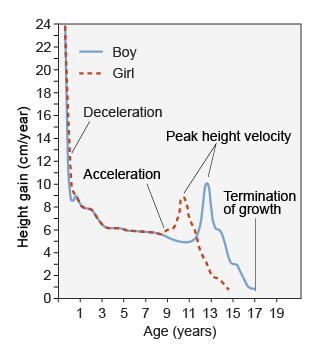1 How fast do teenagers grow?
We all know that teenagers grow quickly, but are there patterns to growth during the teenage years? Are there variations?
Working with teenagers is stimulating because they experience so many changes taking place. It is important to fully understand teenage growth beyond the well-known truism that girls mature faster than boys, since it has implications in terms of training, selection and potential for injury.
Activity 1 Investigating height and growth
In this activity, you are asked to interpret a graph. Look at the graph in Figure 1, which shows the typical height gain per year for boys and girls through childhood and adolescence. The vertical axis shows the height gain in centimetres per year, while the horizontal axis shows the age in years. So you can see that at aged five, the average number of centimetres gained in a year, for both boys and girls, is 5 cm.
- What is the graph saying about the time of the teenage surge in growth?
- The lines on the graph are very precise. How normal do you think this is?
Discussion
- A label of ‘peak height velocity’ draws our attention to the maximum surge in growth, with a striking difference in the lines between boys (blue) and girls (red). The duration of this period of accelerated growth, called the adolescent growth spurt, is usually greater in boys than girls, although there is considerable variation. In girls, this typically occurs around 10 to 13 years of age; in boys, it occurs between 12 and 15 years of age. On completion of the adolescent growth spurt, men are, on average, taller and heavier than women. This is typical of all cultures and ethnicities. The graph suggests that peak height gains can be in the region of 10 cm/year, which are quite substantial changes, particularly in any activity where size is important.
- The line is changing but irregular. We have to assume that this is an average among a number of young people. Most people differ from such an ‘average’.
You will know that often there are early or late developers who fall outside of the line in Figure 1. Add to this the potential impact of having an early (i.e. September) or late (i.e. August) birthday and enormous differences in size/power can be evident: often sporting ‘talent’ gets confused with physical development.

